2014年瘾疹(荨麻疹)诊疗方案
皮肤科瘾疹(慢性荨麻疹)中医临床路径(试行版)

瘾疹(慢性荨麻疹)中医临床路径路径说明:本路径适用于西医诊断为慢性荨麻疹的门诊患者。
一、瘾疹(慢性荨麻疹)中医临床路径标准门诊流程(一)适用对象中医诊断:第一诊断为瘾疹(TCD编码为:BWP110)。
西医诊断:第一诊断为慢性荨麻疹(ICD-10编码为:L50.802)。
(二)诊断依据1.疾病诊断(1)中医诊断标准:参照中华人民共和国中医药行业标准《中医皮肤科病证诊断疗效标准》(ZY/T001.8-94)。
(2)西医诊断标准:参照《临床诊疗指南-皮肤病与性病分册》(中华医学会编著,人民卫生出版社,2006年)和《中国临床皮肤病学》(赵辨主编,江苏科学技术出版社,2010年)。
2.证候诊断参照国家中医重点专科瘾疹(慢性荨麻疹)协作组制定的“瘾疹(慢性荨麻疹)中医诊疗方案”。
瘾疹(慢性荨麻疹)临床常见证候:风热犯表证风寒束表证胃肠湿热证血虚风盛证(三)治疗方案的选择参照国家中医重点专科瘾疹(慢性荨麻疹)协作组制定的“瘾疹(慢性荨麻疹)中医诊疗方案”。
1.诊断明确,第一诊断为瘾疹(慢性荨麻疹)。
2.患者适合并接受中医治疗。
(四)标准治疗时间为≤56天(五)进入路径标准1.第一诊断必须符合瘾疹(慢性荨麻疹)的患者。
2.对已使用西药治疗的患者,维持原剂量并逐渐减量,可进入本路径。
3.合并严重心血管、肝、肾、脑和造血系统等原发性疾病且病情不稳定,需首要接受内科治疗者;合并有需要系统治疗(如:使用大量糖皮质激素或者免疫抑制剂等)的结缔组织病患者;妊娠期或哺乳期妇女、急性荨麻疹(病程小于6周)患者不进入本路径。
4.当患者同时具有其他疾病,但不需特殊处理也不影响第一诊断的临床路径流程实施时,可进入本路径。
(六)中医证候学观察四诊合参,收集该病种不同证候的主症、次症、舌、脉特点。
注意证候的动态变化。
(七)门诊检查项目根据病情需要,可选择血常规、尿常规、肝功能、肾功能、过敏原检测、相关免疫学检查、感染性疾病筛查、腹部B超等。
2014年荨麻疹指南

P O S I T I O N P A P E RThe EAACI/GA2LEN/EDF/WAO Guideline for the definition, classification,diagnosis,and management of urticaria:the2013revision and updateT.Zuberbier1,W.Aberer2,R.Asero3,C.Bindslev-Jensen4,Z.Brzoza5,G.W.Canonica6,M.K.Church1,L.F.Ensina7,A.Gim e nez-Arnau8,K.Godse9,M.Goncßalo10,C.Grattan11,J.Hebert12,M.Hide13,A.Kaplan14,A.Kapp15,A.H.Abdul Latiff16,P.Mathelier-Fusade17,M.Metz1,A.Nast1,S.S.Saini18,M.S a nchez-Borges19,P.Schmid-Grendelmeier20,F.E.R.Simons21,P.Staubach22,G.Sussman23,E.Toubi24,G.A.Vena25,B.Wedi15,X.J.Zhu26& M.Maurer11Department of Dermatology and Allergy,Allergy-Centre-Charit e,Charit e–University Hospital Berlin,Berlin,Germany;2Department of Dermatology,Medical University of Graz,Graz,Austria;3Allergy Clinic,Clinica San Carlo,Paderno Dugnano,MI,Italy;4Department of Dermatology and Allergy Centre,Odense University Hospital,University of Southern Denmark,Odense,Denmark;5Department of Internal Diseases,Allergology and Clinical Immunology in Katowice,Medical University of Silesia,Zabrze,Poland;6Respiratory Diseases&Allergy, University of Genoa,IRCCS AOU SanMartino,Genoa,Italy;7Department of Clinical Immunology and Allergy,Federal University of Sao Paulo, Sao Paulo,Brazil;8Hospital del Mar.Parc de Salut Mar,Universitat Aut o noma Barcelona,Barcelona,Spain;9Department of Dermatology,Dr.D.Y.Patil Medical College&Hospital,Nerul,Navi Mumbai,India;10Clinic of Dermatology,Faculty of Medicine and University Hospital, Coimbra,Portugal;11St John’s Institute of Dermatology,Guy’s and St Thomas’Hospitals NHS Foundation Trust,London,UK;12Center for Applied Research on Allergy Qu e bec,Qu e bec,QC,Canada;13Department of Dermatology,Institute of Biomedical and Health Sciences, Hiroshima University,Hiroshima,Japan;14Division of Pulmonary and Critical Care Medicine,Allergy and Clinical Immunology,Department of Medicine,Medical University of South Carolina,Charleston,SC,USA;15Department of Dermatology and Allergy,Hannover Medical School, Hannover,Germany;16Department of Paediatrics,Pantai Hospital Kuala Lumpur,Bangsar,Kuala Lumpur,Malaysia;17Department of Dermatology and Allergy,University Hospital of Tenon,Paris,France;18Johns Hopkins Asthma and Allergy Center,Baltimore,MD,USA;19Allergy and Clinical Immunology Department Centro M e dico-Docente La Trinidad,Caracas,Venezuela;20Allergy Unit,Department of Dermatology,University Hospital,Z€u rich,Switzerland;21Departments of Pediatrics&Child Health,Immunology,University of Manitoba, Winnipeg,MB,Canada;22Department of Dermatology,University Medical Center Mainz,Mainz,Germany;23Division of Allergy and Clinical Immunology,University of Toronto,Toronto,ON,Canada;24Bnai-Zion Medical Center,Faculty of Medicine,Technion,Haifa,Israel;25Unit of Dermatology and Venereology,Department of Biomedical Sciences and Human Oncology,University of Bari,Bari,Italy;26Department of Dermatology,Peking University First Hospital,Beijing,ChinaTo cite this article:Zuberbier T,Aberer W,Asero R,Bindslev-Jensen C,Brzoza Z,Canonica GW,Church MK,Ensina LF,Gim e nez-Arnau A,Godse K,Goncßalo M, Grattan C,Hebert J,Hide M,Kaplan A,Kapp A,Abdul Latiff AH,Mathelier-Fusade P,Metz M,Nast A,Saini SS,S a nchez-Borges M,Schmid-Grendelmeier P, Simons FER,Staubach P,Sussman G,Toubi E,Vena GA,Wedi B,Zhu XJ,Maurer M.The EAACI/GA2LEN/EDF/WAO Guideline for the definition,classification, diagnosis,and management of urticaria:the2013revision and update.Allergy2014;69:868–887.Keywordsangioedema;consensus;hives;urticaria; wheal.CorrespondenceTorsten Zuberbier,Department of Dermatology and Allergy,Allergy Centre Charit e,Charit e University Hospital Berlin, Charit e platz1,D-10117Berlin,Germany. Tel.:+49-30-450-518135Fax:+49-30-450-518919E-mail:torsten.zuberbier@charite.de*Endorsing societies are listed in Appendix1.Accepted for publication30September 2013AbstractThis guideline is the result of a systematic literature review using the‘Grading of Recommendations Assessment,Development and Evaluation’(GRADE)method-ology and a structured consensus conference held on28and29November2012, in Berlin.It is a joint initiative of the Dermatology Section of the European Aca-demy of Allergy and Clinical Immunology(EAACI),the EU-funded network of excellence,the Global Allergy and Asthma European Network(GA2LEN),the European Dermatology Forum(EDF),and the World Allergy Organization (WAO)with the participation of delegates of21national and international socie-ties.Urticaria is a frequent,mast cell-driven disease,presenting with wheals,an-gioedema,or both.The life-time prevalence for acute urticaria is approximately 20%.Chronic spontaneous urticaria and other chronic forms of urticaria do not only cause a decrease in quality of life,but also affect performance at work and school and,as such,are members of the group of severe allergic diseases.This guideline covers the definition and classification of urticaria,taking into account the recent progress in identifying its causes,eliciting factors and pathomecha-DOI:10.1111/all.12313 Edited by:Thomas Bieber nisms.In addition,it outlines evidence-based diagnostic and therapeutic approaches for the different subtypes of urticaria.This guideline was acknowl-edged and accepted by the European Union of Medical Specialists(UEMS).This guideline is the result of a systematic literature review using the‘Grading of Recommendations Assessment,Develop-ment and Evaluation’(GRADE)methodology and a structured consensus conference held on28and29November2012,in Berlin.It is a joint initiative of the European Academy of Allergy and Clinical Immunology(EAACI)Dermatology Sec-tion,GA2LEN,the European Dermatology Forum(EDF), and the World Allergy Organization(WAO)with the participa-tion of delegates of21national and international societies.The American Academy of Allergy,Asthma&Immunology (AAAAI)participated in the process of developing these guide-lines,but is not an endorsing founder society(see Acknowledg-ments).It is an update and revision of the previous EAACI/ GA2LEN/EDF/WAO guidelines on urticaria(1,2).The wide diversity and number of different urticaria subtypes that have been identified reflect,at least in part,our increasing understanding of the causes and eliciting factors of urticaria and the molecular and cellular mechanisms involved in its pathogenesis.The aim of this guideline is to provide an updated definition and classification of urticaria,thereby facilitating the interpretation of divergent data from different centers regard-ing underlying causes,eliciting factors,and therapeutic respon-siveness of subtypes of urticaria.Furthermore,this guideline provides recommendations for diagnostic and therapeutic approaches in common subtypes of urticaria.This guideline has involved societies and experts from all areas of the world and as a global guideline thus also takes into consideration that causative factors in patients,medical systems,and access to diagnosis and treatment vary in different countries.MethodsThe detailed methods used in the development of this guide-line2013revision and update,including all evaluations of the literature,are published in a separate paper for the sake of brevity and readability.A brief summary is provided here as Appendix2.In short,as members of the panel and delegates of their soci-eties,the authors had prepared in advance their suggestions regarding the definition,classification,diagnosis,and treat-ment of urticaria.The resulting draft of the guideline took into account all available evidence in the literature(including Med-line and Embase searches as well as manual search of abstracts at international allergy congresses between2004and2012)and was based on the existing consensus papers of thefirst three symposia in2000,2004,and2008(1–6).These suggestions were then discussed in detail between the panel and the partici-pants of the meeting.A consensus wasfinally achieved during a structured consensus conference using a TED voting system. The participation of urticaria specialists from39countries ensured that this consensus includes regional differences worldwide in viewpoint and provides a basis for improved comparison of future studies in thefield of urticaria.In the previous version of the guideline,studies were already partly evaluated using the GRADE approach.The key principle of the GRADE approach is to provide trans-parency and clear,explicit criteria for assessing the quality of evidence(see Table1)and grading the strength of recommen-dations(7–11)based on risk vs benefits.The following translation to the GRADE quality of evi-dence was used acknowledging that a more detailed assess-ment will possibly change the quality of evidence and that additional quality criteria are considered in GRADE.SIGN level of evidence GRADE quality of evidence1++High1+Moderate1ÀLow2++Low2+Low2ÀVery low3Very low4Very lowFor this2013revision and update,a modified version of GRADE was applied throughout the guideline.The questions addressed were developed by the panel members and selected with respect to their relevance by all the panel members in a Delphi voting.The selection and wording process used as well as other methodological details are described in a separate Table1Levels of evidence for identified literature sourcesThe quality of the evidence was assessed using the Methodology Checklist2:RCTs of the Scottish Intercollegiate Guidelines Network(SIGN;compare for(2))1++High-quality meta-analyses,systematic reviews of RCTs,or RCTs with a very low risk of bias1+Well-conducted meta-analyses,systematic reviews of RCTs, or RCTs with a low risk of bias1ÀMeta-analyses,systematic reviews of RCTs,or RCTs with a high risk of bias2++High-quality systematic reviews of case-controlled or cohort or studies.High-quality case-controlled or cohort studieswith a very low risk of confounding,bias,or chance and ahigh probability that the relationship is causal2+Well-conducted case-controlled or cohort studies with a low risk of confounding,bias,or chance and a moderateprobability that the relationship is causal2ÀCase-controlled or cohort studies with a high risk ofconfounding,bias,or chance and a significant risk that therelationship is not causal3Nonanalytic studies,for example case reports,case series 4Expert opinionRCT,randomized controlled trials.Zuberbier et al.EAACI/GA2LEN/EDF/WAO urticaria guidelinereport on methods used for the generation of this revision and update of the guideline.Briefly,the strength of a recommendation and the quality of supporting evidence were assessed indepen-dently by two assessors for each recommendation.They took into consideration as negative/risk:side-effects(graded on severity)and costs;and as benefits:reduction in urticaria symptoms(e.g.,UAS7[UAS,Urticaria Activity Score;UAS7, Average Urticaria Activity Score for7days]in newer studies) and improvement in quality of life(QoL).Importantly,the GRADE system permits strong recommendations supported by low-or(very rarely)very-low-quality evidence from down-graded RCTs or observational studies.On the other hand,weak recommendations may be based on high-quality evidence if other factors are important,for example the price of a treatment option.The expression‘we recommend’was used for strong rec-ommendations and‘we suggest’for weak recommendations in order to adhere to the same methodology used for the Allergic Rhinitis and its Impact on Asthma guideline2008 update(10).This same terminology has also been adhered to in those parts of the guideline where the assessment of the evidence was not done in full.Participants of the consensus conference were presented with a draft version of this document and were asked to dis-cuss and vote whether they agreed with recommendations and other specific parts of the text.It was only allowed to vote yes or no,to ensure clear majority decisions.In state-ments not receiving votes>90%during thefirst voting,the recommendation was re-discussed,rephrased,and re-voted and passed in the following votings if a minimum of>75% agreement was achieved.Conflicts of interest of all group members were collected prior to the consensus conferences.They were assessed by the steering committee.All declarations of conflicts of inter-est are presented as online Supporting Information to this guideline and in detail in the methods report.DefinitionUrticaria is a disease characterized by the development of wheals(hives),angioedema,or both.Urticaria needs to be differentiated from other medical conditions where wheals, angioedema,or both can occur as a symptom,for example skin prick test,anaphylaxis,auto-inflammatory syndromes, or hereditary angioedema(bradykinin-mediated angioedema). Clinical appearanceUrticaria is characterized by the sudden appearance of wheals,angioedema,or both.A wheal consists of three typical features:1It is characterized by a central swelling of variable size, almost invariably surrounded by a reflex erythema.2It is associated with itching or sometimes a burning sen-sation.3It has afleeting nature,with the skin returning to its nor-mal appearance,usually within1–24h.Sometimes wheals resolve even more quickly.Angioedema is characterized by 1A sudden,pronounced erythematous or skin-colored swelling of the lower dermis and subcutis with frequent involvement below mucous membranes and2Sometimes pain rather than itching and frequent involve-ment below mucous membranes.Its resolution is slower than that for wheals and can take up to72h. Pathophysiological aspectsUrticaria is a mast-cell-driven disease.Histamine and other mediators,such as platelet-activating factor(PAF)and cyto-kines released from activated mast cells,result in sensory nerve activation,vasodilatation,and plasma extravasation as well as cell recruitment to urticarial lesions.The mast-cell-activating signals in urticaria are ill-defined and likely to be heterogeneous and diverse.Histologically,wheals are character-ized by edema of the upper and mid-dermis,with dilatation of the postcapillary venules and lymphatic vessels of the upper dermis.In angioedema,similar changes occur primarily in the lower dermis and the subcutis.Skin affected by wheals virtually always exhibits upregulation of endothelial cell adhesion mole-cules and a mixed inflammatory perivascular infiltrate of vari-able intensity,consisting of neutrophils and/or eosinophils, macrophages,and T cells,but without vessel-wall necrosis, which is a hallmark at urticaria vasculitis(12–14).A mild-to-moderate increase of mast cell numbers has also been reported by some authors.In delayed pressure urticaria,the infiltrate is typically located in the mid-to lower dermis.In some subtypes of urticaria,up-regulation of adhesion molecules(15)and altered cytokine expression are also seen in uninvolved skin (16).Thesefindings underline the complex nature of the patho-genesis of urticaria,which has many features in addition to the release of histamine from dermal mast cells(17,18).These changes are also seen in a wide variety of inflamma-tory reactions and are thus not specific or of diagnostic value.A search for more specific histological biomarkers for different subtypes of urticaria is desirable.Considerations about patient-related outcomes in patients with urticariaQuality of lifePatient-related outcomes are important to be looked at in the treatment for urticaria(19).The available data indicate that urticaria has a detrimental effect on both objective function-ing and subjective well-being.For example,O’Donnell et al.(20)showed that health status scores in patients with chronic spontaneous urticaria(CSU)are comparable to those reported by patients with coronary artery disease.Further-more,both health status and subjective satisfaction in patients with CSU are lower than in healthy subjects and in patients with respiratory allergy(21).A study of Poon et al.(22)focused on the extent and nature of disability in different types of urticaria,showing a large variation in Health-Related Quality of Life(HR-QoL)scores within different urticarial subsets.In this study,the assessment of HR-QoL was performed using generic tools.A QoL Questionnaire specifically developed for CSU was validated,including physical,emotional,social,and practicalEAACI/GA2LEN/EDF/WAO urticaria guideline Zuberbier et al.aspects characteristic of this condition (23).This new tool named Chronic Urticaria Quality of Life Questionnaire (CU-Q2oL)was originally generated and tested in the Italian language following well-established procedures.The CU-Q2oL meets the standards for validity with good construct validity,internal consistency,reliability,and responsiveness.These psychometric characteristics make it suitable for the assessment of the health burden of CSU.It has now been translated and validated in German,Spanish,Polish,Turk-ish,Greek,Bulgarian,Brazilian-Portuguese,and other ver-sions are currently being validated (24–28).In addition,another questionnaire covers patients with angioedema (29).The Angioedema Quality of Life Questionnaire (AE-QoL),a symptom-specific Qol instrument,has been developed in Ger-man (29)and has been translated in various languages,including English (USA),Spanish,French,Azeri,Swedish,Hungarian,Romanian,Greek,and Polish.Classification of urticaria on the basis of its duration,frequency,and causesThe spectrum of clinical manifestations of different urticaria subtypes is very wide.Additionally,two or more different subtypes of urticaria can coexist in any given patient.Acute urticaria is defined as the occurrence of spontaneous wheals,angioedema,or both for <6weeks.Table 2presents a classification for clinical use of chronic urticaria subtypes.This revised classification deals with previous inconsistencies,for example physical urticarias may also be chronicconditions,but they were grouped separately due to the special nature of their eliciting physical factors.Urticaria pigmentosa (cutaneous mastocytosis),urticaria vasculitis ,auto-inflammatory syndromes (e.g.,cryopyrin-associated periodic syndromes or Schnitzler’s syndrome),and nonmast cell mediators mediated/induced angioedema (e.g.,bradyki-nin-mediated angioedema)are not considered to be subtypes of urticaria,due to their distinctly different pathomecha-nisms,but are listed in Table 3for reference.Wheals are also features of several syndromes (Table 3).Assessment of disease activity and impactDisease activity in spontaneous urticaria should be assessed both in clinical care and in trials with the UAS7(Table 4),a unified and simple scoring system that was proposed in the last version of the guidelines and has been validated (30).The signs and symptoms are evaluated by the patient making this score especially valuable.The use of the UAS facilitates com-Table 2Classification of chronic urticaria subtypes (presenting with wheals,angioedema,or both)Chronic urticaria subtypes Chronic spontaneous urticaria Inducible urticariaSpontaneous appearance of wheals,angioedema,orboth ≥6weeks due to known or unknown causesSymptomatic dermographism *Cold urticaria †Delayed pressure urticaria ‡Solar urticaria Heat urticaria §Vibratory angioedema Cholinergic urticaria Contact urticaria Aquagenic urticaria*also called urticaria factitia ,dermographic urticaria;†also called cold contact urticaria;‡also called pressure urticaria;§also called heat contact urticaria.Table 3Diseases related to urticaria for historical reasons and syndromes that present with hives and/or angioedema Maculopapular cutaneous mastocytosis (urticaria pigmentosa) Urticarial vasculitisBradykinin-mediated angioedema (e.g.,HAE) Exercise-induced anaphylaxisCryopyrin-associated periodic syndromes (CAPS;urticarial rash,recurrent fever attacks,arthralgia or arthritis,eye inflammation,fatigue and headaches),that is,familial cold autoinflammatory syndrome (FCAS),Muckle –Wells syndrome (MWS),or neonatal onset multisystem inflammatory disease (NOMID).Schnitzler’s syndrome (recurrent urticarial rash and monoclonal gammopathy,recurrent fever attacks,bone and muscle pain,arthralgia or arthritis and lymphadenopathyGleich’s syndrome (episodic angioedema with eosinophilia) Well’s syndrome (Granulomatous dermatitis with eosinophilia)These diseases and syndromes are related to urticaria (i)because they present with wheals,angioedema,or both and/or (ii)because of historical reasons.Table 4The UAS7for assessing disease activity in CSU ScoreWhealsPruritus0NoneNone1Mild (<20wheals/24h)Mild (present but notannoying or troublesome)2Moderate (20–50wheals/24h)Moderate (troublesome but does not interfere with normal daily activity or sleep)3Intense (>50wheals/24h or large confluent areas of wheals)Intense (severe pruritus,which is sufficientlytroublesome to interfere with normal daily activity or sleep)Sum of score:0–6for each day is summarized over one week (maximum 42).Zuberbier et al.EAACI/GA 2LEN/EDF/WAO urticaria guidelineparison of study results from different centers.The UAS is based on the assessment of key urticaria symptoms (wheals and pruritus).It is suitable for the evaluation of disease activ-ity by urticaria patients and their treating physicians.Further-more,this scoring system has been widely used in trials and should thus be maintained for future comparison.As urticaria symptoms change frequently in intensity,the overall disease activity is best measured by advising patients to document 24-h self-evaluation scores once daily for several days.A modifi-cation of the UAS7assessing signs and symptoms two times per day was also validated (31),but voting preferred to use the classical UAS because (i)measuring only once daily for the last 24h does give a bias in patients with primarily noc-turnal symptoms only and (ii)it has been more widely used and it is important to use the same tool worldwide in trials to allow comparison.The UAS7,that is,the sum score of seven consecutive days,should be used in routine clinical practice to determine disease activity and response to treatment of patients with CSU,as well as in some cases of patients with inducible or physical urticaria as well.For patients with an-gioedema,a novel activity score,the Angioedema Activity Score has been developed and validated (29).In addition to disease activity,it is important to assess the impact of disease on QoL both in clinical practice and in trials.In physical urticaria and in cholinergic urticaria,the threshold of the eliciting factor(s)should be determined to assess severity,for example critical temperature and stimula-tion time thresholds for cold provocation in cold urticaria.These thresholds allow both patients and treating physicians to evaluate disease activity and response to treatment.Diagnosis of urticariaIn the last two decades,many advances have been made in identifying causes of different types and subtypes of urticaria,for example,in CSU reviewed in Refs (32–33).Among oth-ers,autoreactivity including autoimmunity mediated by func-tional autoantibodies directed against the IgE receptor,pseudo-allergy (nonallergic hypersensitivity reactions)to foods and drugs,and acute or chronic infections (e.g.,Heli-cobacter pylori or Anisakis simplex )have been described (34–44)(Table 5).However,there are considerable variations in the frequency of underlying causes in the different studies.This also reflects regional differences in the world,forexample,different traditional diets and different prevalence of infections.Thus,it is important to remember that not all possible causative factors need to be investigated in all patients and the first step in diagnosis is a thorough history,taking the following questions into consideration:1Time of onset of disease2Frequency/duration of and provoking factors for wheals 3Diurnal variation4Occurrence in relation to weekends,holidays,and for-eign travel5Shape,size,and distribution of wheals 6Associated angioedema7Associated subjective symptoms of lesions,for exampleitch,pain8Family and personal history regarding urticaria,atopy 9Previous or current allergies,infections,internal diseases,or other possible causes10Psychosomatic and psychiatric diseases11Surgical implantations and events during surgery,forexample after local anesthesia 12Gastric/intestinal problems13Induction by physical agents or exercise14Use of drugs (e.g.,non-steroidal anti-inflammatorydrugs (NSAIDs),injections,immunizations,hormones,laxatives,suppositories,ear and eye drops,and alterna-tive remedies)15Observed correlation to food16Relationship to the menstrual cycle17Smoking habits (especially use of perfumed tobaccoproducts or cannabis)18Type of work 19Hobbies20Stress (eustress and distress)21Quality of life related to urticaria and emotional impact 22Previous therapy and response to therapy 23Previous diagnostic procedures/resultsThe second step of the diagnosis is the physical examina-tion of the patient.This should include a diagnostic provoca-tion test including drug,food,and physical tests where it is indicated by history.All subsequent diagnostic steps will depend very much on patient history and on the nature of the urticaria subtype,as summarized in Fig.1and Table 5.EAACI/GA 2LEN/EDF/WAO urticaria guidelineZuberbier et al.Intensive and costly general screening programs for causesof urticaria are strongly advised against.The following fac-tors should only be investigated based on patient history.Type I allergy is a rare cause of CSU in patients who presentwith daily or almost daily symptoms,but may be consideredin CSU patients with intermittent symptoms.In contrast,pseudo-allergic(non-allergic hypersensitivity reactions)toNSAIDs food or food additives may be more relevant forCSU with daily symptoms.Diagnosis should be based on aneasy-to-follow diet protocol(see patient information page indifferent languages under /).Bacterial,viral,parasitic,or fungal infections,for example,with H.pylori,Streptococci,Staphylococci,Versinia,Giardialamblia,Mycoplasma pneumonia,Hepatitis virus,Norovirus,Parvovirus B19,Anisakis simplex,Entamoeba ssp.,Blastocystis Table5Recommended diagnostic tests in frequent urticaria subtypesTypes SubtypesRoutine diagnostic tests(recommended)Extended diagnostic program*(suggested based onhistory only)For identification of underlying causes or elicitingfactors and for ruling out possible differential diagnosesif indicatedSpontaneousurticariaAcute spontaneous urticaria None None†Chronic spontaneousurticariaDifferential blood count.ESR or CRPOmission of suspecteddrugs(e.g.,NSAID)Test for(in no preferred order):(i)infectious diseases(e.g.,Helicobacter pylori),(ii)type I allergy,(iii)functional autoantibodies,(iv)thyroid hormonesand autoantibodies,(v)skin tests including physicaltests,(vi)pseudoallergen-free diet for3weeks,(vii)tryptase‡,(viii)autologous serum skin test,and(ix)lesional skin biopsyInducibleurticariaCold urticaria Cold provocation andthreshold test(ice cube,cold water,cold wind)Differential blood count and ESR or CRP cryoproteinsrule out other diseases,especially infections Delayed pressure urticaria Pressure test andthreshold testNoneHeat urticaria Heat provocation andthreshold testNoneSolar urticaria UV and visible light ofdifferent wavelengthsand threshold testRule out other light-induced dermatosesSymptomaticdermographismVibratory AngioedemaElicit dermographismand thresholdtest(dermographometer)Test with,for example,vortexDifferential blood count,ESR or CRPNoneAquagenic urticaria Wet cloths at bodytemperatureapplied for20minNoneCholinergic urticaria Exercise and hot bath provocation NoneContact urticaria Cutaneous provocationtest.Skin tests withimmediate readings,for example prick testNoneESR,erythrocyte sedimentation rate;CRP,C-reactive protein.*Depending on suspected cause.†Unless strongly suggested by patient history,for example allergy.‡As indication of severe systemic disease.Zuberbier et al.EAACI/GA2LEN/EDF/WAO urticaria guideline。
瘾疹(荨麻疹)
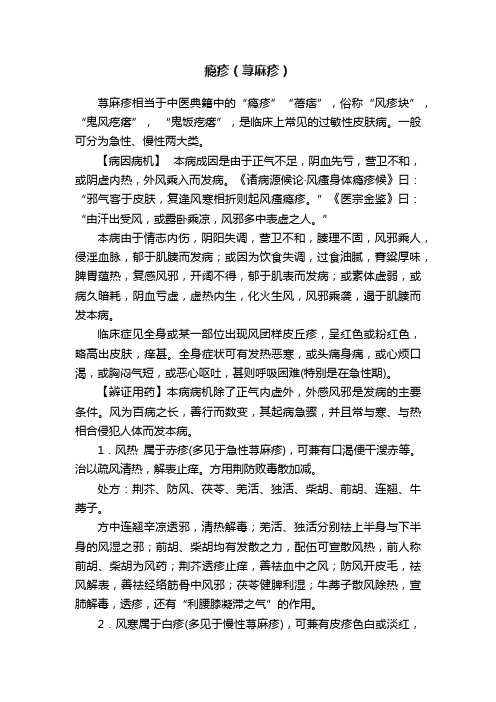
瘾疹(荨麻疹)荨麻疹相当于中医典籍中的“瘾疹”“蓓痞”,俗称“风疹块”,“鬼风疙瘩”,“鬼饭疙瘩”,是临床上常见的过敏性皮肤病。
一般可分为急性、慢性两大类。
【病因病机】本病成因是由于正气不足,阴血先亏,营卫不和,或阴虚内热,外风乘入而发病。
《诸病源候论·风瘙身体瘾疹候》曰:“邪气客于皮肤,复逢风寒相折则起风瘙瘾疹。
”《医宗金鉴》曰:“由汗出受风,或露卧乘凉,风邪多中表虚之人。
”本病由于情志内伤,阴阳失调,营卫不和,腠理不固,风邪乘人,侵淫血脉,郁于肌腠而发病;或因为饮食失调,过食油腻,膏粱厚味,脾胃蕴热,复感风邪,开阔不得,郁于肌表而发病;或素体虚弱,或病久暗耗,阴血亏虚,虚热内生,化火生风,风邪乘袭,遏于肌腠而发本病。
临床症见全身或某一部位出现风团样皮丘疹,呈红色或粉红色,略高出皮肤,痒甚。
全身症状可有发热恶寒,或头痛身痛,或心烦口渴,或胸闷气短,或恶心呕吐,甚则呼吸困难(特别是在急性期)。
【辨证用药】本病病机除了正气内虚外,外感风邪是发病的主要条件。
风为百病之长,善行而数变,其起病急骤,并且常与寒、与热相合侵犯人体而发本病。
1.风热属于赤疹(多见于急性荨麻疹),可兼有口渴便干溲赤等。
治以疏风清热,解表止痒。
方用荆防败毒散加减。
处方:荆芥、防风、茯苓、羌活、独活、柴胡、前胡、连翘、牛蒡子。
方中连翘辛凉透邪,清热解毒;羌活、独活分别祛上半身与下半身的风湿之邪;前胡、柴胡均有发散之力,配伍可宣散风热,前人称前胡、柴胡为风药;荆芥透疹止痒,善祛血中之风;防风开皮毛,祛风解表,善祛经络筋骨中风邪;茯苓健脾利湿;牛蒡子散风除热,宣肺解毒,透疹,还有“利腰膝凝滞之气”的作用。
2.风寒属于白疹(多见于慢性荨麻疹),可兼有皮疹色白或淡红,遇风遇冷加剧。
治用辛温透表,疏风止痒。
方用桂枝汤加味。
处方:桂枝、白芍、甘草、生姜、大枣、荆芥、防风、蝉蜕、白鲜皮。
方中桂枝解肌散风祛寒,白芍益阴敛营,两药相合,一治卫强,一治营弱,相须为用,调和营卫;生姜既助桂枝解肌,又能暖胃止呕,大枣则能补中益气,又滋脾生津,两药合用可升脾胃升发之气而调和营卫;荆芥解肌透疹;防风散风解表;甘草益气和中,合桂枝以解肌,合白芍益阴;自鲜皮祛内伏蕴湿;蝉蜕散热透疹,祛风止痒。
简化2014中国荨麻疹指南
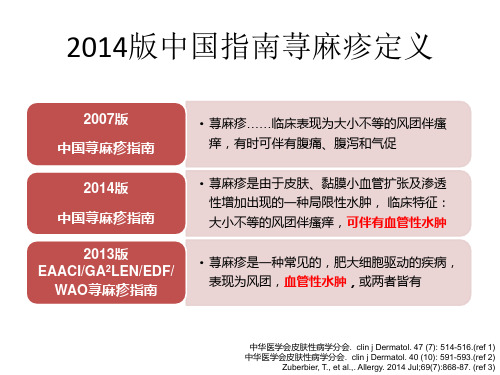
• 荨麻疹是一种常见的,肥大细胞驱动的疾病,
表现为风团,血管性水肿,或两者皆有
中华医学会皮肤性病学分会. clin j Dermatol. 47 (7): 514-516.(ref 1) 中华医学会皮肤性病学分会. clin j Dermatol. 40 (10): 591-593.(ref 2) Zuberbier, T., et al.,. Allergy. 2014 Jul;69(7):868-87. (ref 3)
中华医学会皮肤性病学分会. clin j Dermatol. 47 (7): 514-516.(ref 1)
2014版中国指南不推荐对所有荨 麻疹患者均行常规辅助检查
2014版中国荨麻疹指南
• 通常荨麻疹不需要做更多的检查
2013版EAACI/GA2LEN/EDF/WAO荨麻疹指南
• 反对对急性荨麻疹进行任何常规检查 • 慢性自发性荨麻疹只需极其有限的常规检查
结论 1.奥洛他定快速、强效止痒,瘙痒降低程 度优于左西替利嗪 2.强效、持久抑制风团长达 24小时,优于 左西替利嗪
2014版中国指南荨麻疹定义
2007版 中国荨麻疹指南 2014版 中国荨麻疹指南 2013版 EAACI/GA2LEN/EDF/ WAO荨麻疹指南
• 荨麻疹……临床表现为大小不等的风团伴瘙 痒,有时可伴有腹痛、腹泻和气促 • 荨麻疹是由于皮肤、黏膜小血管扩张及渗透 性增加出现的一种局限性水肿, 临床特征: 大小不等的风团伴瘙痒,可伴有血管性水肿
Hennino, A., et al.,. Clin Rev Allergy Immunol, 2006. 30(1): p. 3-11. (ref 7)
2014版中国指南对荨麻疹进行了重 新分类
中国荨麻疹诊疗指南
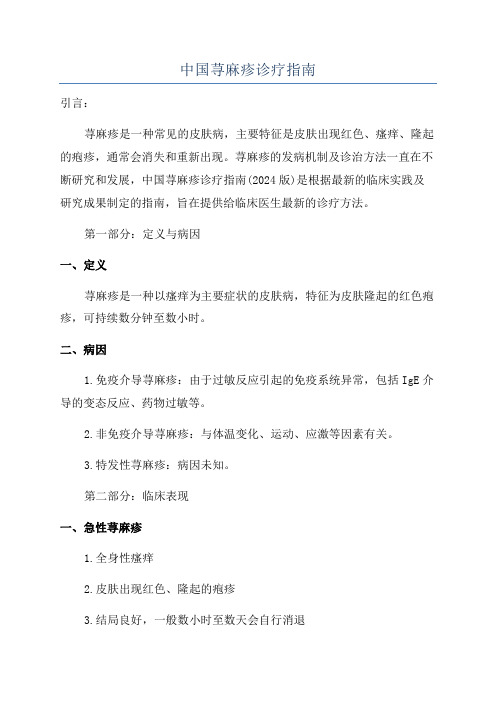
中国荨麻疹诊疗指南引言:荨麻疹是一种常见的皮肤病,主要特征是皮肤出现红色、瘙痒、隆起的疱疹,通常会消失和重新出现。
荨麻疹的发病机制及诊治方法一直在不断研究和发展,中国荨麻疹诊疗指南(2024版)是根据最新的临床实践及研究成果制定的指南,旨在提供给临床医生最新的诊疗方法。
第一部分:定义与病因一、定义荨麻疹是一种以瘙痒为主要症状的皮肤病,特征为皮肤隆起的红色疱疹,可持续数分钟至数小时。
二、病因1.免疫介导荨麻疹:由于过敏反应引起的免疫系统异常,包括IgE介导的变态反应、药物过敏等。
2.非免疫介导荨麻疹:与体温变化、运动、应激等因素有关。
3.特发性荨麻疹:病因未知。
第二部分:临床表现一、急性荨麻疹1.全身性瘙痒2.皮肤出现红色、隆起的疱疹3.结局良好,一般数小时至数天会自行消退二、慢性荨麻疹1.持续或反复出现荨麻疹疱疹,持续超过6周2.结局不一,有的会痊愈,有的会持续数年第三部分:诊断一、根据病史和症状1.病史:详细询问发作时间、消失时间、出现诱因等。
2.症状:红色、隆起的疱疹,伴有瘙痒。
二、实验室检查1.皮肤划痕试验:用尖锐器轻轻划破皮肤后观察是否出现红色、隆起的疱疹。
2.血清IgE水平测定:可用于判断是否过敏反应引起的。
第四部分:治疗方案一、避免诱因1.避免与过敏源接触2.避免剧烈运动、高温等刺激二、药物治疗1.抗组胺药物:适用于急性荨麻疹,如非那根、氯雷他定等。
2.变应原免疫治疗:适用于过敏引起的荨麻疹,如单克隆抗体药物。
3.免疫抑制剂:适用于慢性荨麻疹,如环孢素A等。
三、中医中药治疗中医中药可以作为辅助治疗荨麻疹的方法,具体的药方根据病情和体质进行个性化调整。
四、其他治疗1.冷敷或温水浸泡:可以缓解瘙痒、减轻红肿。
2.心理辅导和应激管理:对于因精神压力引起的荨麻疹可进行心理辅导和应激管理。
结语:中国荨麻疹诊疗指南(2024版)是根据最新的临床实践及研究成果制定的指南,为临床医生提供了最新的诊疗方法。
2014版中国荨麻疹指南解读
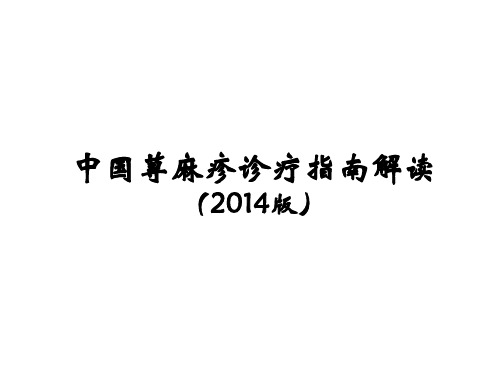
•
定义
荨麻疹临床表现为风团和血管性水肿
慢性荨麻疹表现流行病学数据(ACAAI 2013)
特别强调 “血管性水肿” 的诊断意义
风团和血管性水肿是荨麻疹 常见临床表现
• 有数据显示,33-67%的慢性自发性荨麻疹 同时存在风团和血管性水肿
Maurer, M., et al.,Allergy2011;66: 317–330. (ref 4)
中国荨麻疹诊疗指南解读
(2014版)
制定本指南的目的 指南修订概述
本只南是中华医学会皮肤性病学分会组织免疫学组和有关专家讨 论指定的 分会曾于2007年制定第一版荨麻疹诊疗指南
经过6-7年的发展,国际荨麻疹的治疗方法、理念、药物等有许多 和变化和进步
为了与国际接轨,使我国患者享受到规范治疗,决定修订指南
急性荨麻疹的治疗
• 明确并祛除病因 • 口服抗阻胺药 • 其他: –糖皮质激素:泼尼松(或相当剂量)30~40mg,4~5 天后停药,特别适用于重症或伴有喉头水肿的荨麻疹 – 1:1000肾上腺素溶液0.2~0.4ml皮下或肌内注射,可 以用于急性荨麻疹伴休克或严重的荨麻疹伴血管性水 肿。
慢性荨麻疹的治疗
指南推荐的病史采集内容(21项)
• • • • • • • • • • 可能的诱发因素及缓解因素 病程 发作频率 皮损持续时间 昼夜发作规律 风团大小、数目 风团形状及分布 是否合并血管性水肿 伴随瘙痒或疼痛程度 消退后是否有色素沉着
• • • • • • • • • • •
既往个人或家族中的过敏史 感染病史 内脏疾病史 外伤史 手术史 用药史 心理及精神状况 月经史 生活习惯 工作及生活环境 既往的治疗反应等
药物
植入物
物理因素
荨麻疹中医治疗
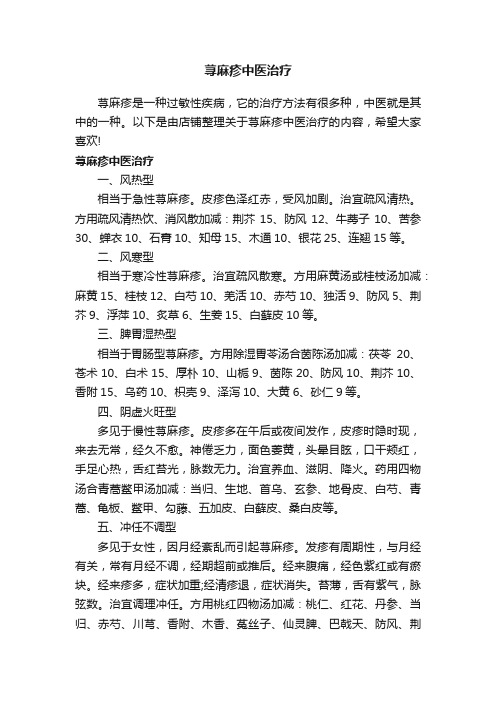
荨麻疹中医治疗荨麻疹是一种过敏性疾病,它的治疗方法有很多种,中医就是其中的一种。
以下是由店铺整理关于荨麻疹中医治疗的内容,希望大家喜欢!荨麻疹中医治疗一、风热型相当于急性荨麻疹。
皮疹色泽红赤,受风加剧。
治宜疏风清热。
方用疏风清热饮、消风散加减:荆芥15、防风12、牛蒡子10、苦参30、蝉衣10、石膏10、知母15、木通10、银花25、连翘15等。
二、风寒型相当于寒冷性荨麻疹。
治宜疏风散寒。
方用麻黄汤或桂枝汤加减:麻黄15、桂枝12、白芍10、羌活10、赤芍10、独活9、防风5、荆芥9、浮萍10、炙草6、生姜15、白藓皮10等。
三、脾胃湿热型相当于胃肠型荨麻疹。
方用除湿胃苓汤合茵陈汤加减:茯苓20、苍术10、白术15、厚朴10、山栀9、茵陈20、防风10、荆芥10、香附15、乌药10、枳壳9、泽泻10、大黄6、砂仁9等。
四、阴虚火旺型多见于慢性荨麻疹。
皮疹多在午后或夜间发作,皮疹时隐时现,来去无常,经久不愈。
神倦乏力,面色萎黄,头晕目眩,口干颊红,手足心热,舌红苔光,脉数无力。
治宜养血、滋阴、降火。
药用四物汤合青蒿鳖甲汤加减:当归、生地、首乌、玄参、地骨皮、白芍、青蒿、龟板、鳖甲、勾藤、五加皮、白藓皮、桑白皮等。
五、冲任不调型多见于女性,因月经紊乱而引起荨麻疹。
发疹有周期性,与月经有关,常有月经不调,经期超前或推后。
经来腹痛,经色紫红或有瘀块。
经来疹多,症状加重;经清疹退,症状消失。
苔薄,舌有紫气,脉弦数。
治宜调理冲任。
方用桃红四物汤加减:桃仁、红花、丹参、当归、赤芍、川芎、香附、木香、菟丝子、仙灵脾、巴戟天、防风、荆芥、甘草等。
六、热毒燔营型多为感染或药物引起的急性荨麻疹或血清病型荨麻疹。
发病突然,皮疹广泛,全身大块状,色绛红,灼热感,奇痒。
伴有发热、恶心、心烦不安,口渴喜饮,面红目赤,小便短赤,大便秘结。
舌红苔黄,脉洪数。
治宜清热、凉血、解毒。
方用清温败毒饮加减;黄连、黄芩、生石膏、知母、银花、玄参、人中黄、芦根、土茯苓、滑石、生草等。
荨麻疹
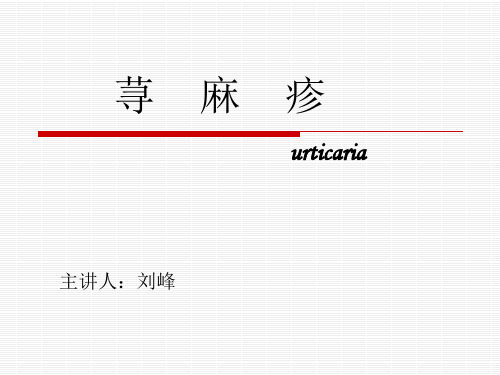
诊断
侵犯消化道粘膜,可伴恶心、呕吐、腹痛腹 泻
发生于咽喉者,可引起喉头水肿和呼吸困难, 有明显气闷窒息感,甚至可发生晕厥。 病程:急性:3个月以内,病程1周左右
慢性:反复发作超过3个月以上,
甚至数年。
诊断
实验室检查:血液嗜酸性粒细胞计数常增高 用已制备的多种食入性、吸入性变应原作皮 肤挑刺、划痕或皮内实验,可有助于寻找致 敏原,但其结果与临床实际情况符合率不高
辨证论治
血虚风燥型 主证:多见于慢性荨麻疹,风团反复发作,久 治不愈.夜间或劳累时风团加重,四肢困倦, 形瘦体弱心烦易怒,口干,手足心热。舌红 少津,脉沉细。 治法:养血祛风润燥止痒。 方药:当归饮子加味
辨证论治
湿热型
主证;出风团与饮食不节有关,伴有腹痛腹泻,或呕 吐,胸 闷.大便稀烂不畅。舌红苔黄腻,脉数或濡数 治法:清肠利显,祛风止痒 方药:土ria
主讲人:刘峰
定义:
本病是皮肤粘膜小血管扩张及渗透性增加而出现的 一种以皮肤上出现瘙痒性风团 ,发无定处,骤起骤退, 退后不留痕迹为特征的过敏性皮肤病。 中医称“瘾疹”; 2014诊疗指南 荨麻疹是由于皮肤、黏膜小血管扩张及渗透性增加 出现的一种局限性水肿反应。临床上特征性表现为 大小不等的风团伴瘙痒,可伴有血管性水肿。慢性 荨麻疹是指风团每周至少发作 2 次,持续≥6 周。 少数慢性荨麻疹患者也可表现为间歇性发作
鉴别诊断
药疹
药疹又称药物性皮炎,过敏反应的最常见类 型。常见的药物有碘胺类药、解热镇痛药、 安眠药类以及青霉素、链霉素等。临床表现 为弥漫鲜红色斑或半米粒大至豆大红色斑丘 疹,密集对称分布,形态如麻疹样或猩红热 样,发病突然,常伴有畏寒、高热(39~ 40℃±)头痛,全身不适等,半数以上病例 在停药后2周完全消退。
李今庸,瘾疹、痒疹用方,风疹,湿疹,瘙痒性、过敏性皮肤病

李今庸,瘾疹、痒疹用方,风疹,湿疹,瘙痒性、过敏性皮肤病一二一、瘾疹用方自拟方治外感风热瘾疹组方:当归10克川芎8克赤芍10克荆芥10克防风10克连翘10克薄荷10克甘草10克茯苓10克紫背浮萍10克治疗:外感风热,血瘀不畅,症见皮肤上突现大小不等、形状不一之皮疹,成块成片,色黄灼热,瘙痒,此起彼消,心中烦乱不适等。
用法:药10味,以适量水煎,汤成去渣,取汁温服,日1剂,分2次服。
荆防败毒散治风寒外袭瘾疹组方:羌活10克独活10克柴胡10克前胡10克茯苓10克炒枳壳10克防风10克荆芥10克桔梗10克川芎8克甘草8克治疗:风寒袭表,气机不利,症见皮肤上突现大小不等、形状不一之皮疹,成块成片,色白,瘙痒,此起彼伏等。
用法:药11味,以适量水煎,汤成去渣,取汁温服,日1剂,分2次服。
桂枝汤加味治风寒袭表瘾疹组方:桂枝10克白芍10克炙甘草8克生姜10克蒴藋10克炒枳实10克大枣3枚(擘)治疗:风寒袭表,营卫不和,症见皮肤上突现大小不等、形状不一之皮疹,成块成片,色白,瘙痒,此起彼伏,并兼见汗出,恶风等。
用法:药7味,以适量水煎,汤成去渣,取汁温服,日1剂,分2次服。
一二二、痒疹用方自拟方治风邪袭表痒疹组方:当归10克赤芍10克炒枳实10克川芎10克荆芥10克防风10克桔梗10克茯苓10克甘草8克治疗:风邪侵袭肌肤之痒疹,症见皮肤上突现形如粟粒或针头样、高于皮肤的小丘疹,或散在或成片,摸之碍手,疹色正红或浅红,瘙痒难忍等。
用法:药9味,以适量水煎,汤成去渣,取汁温服,日1剂,分2次服。
若兼体弱脉虚者,加党参10克。
瘾疹,中医病名。
瘾疹是一种皮肤出现红色或苍白风团,时隐时现的瘙痒性、过敏性皮肤病。
本病以皮肤上出现瘙痒性风团,发无定处,骤起骤退,消退后不留任何痕迹为临床特征。
一年四季均可发病,老幼都可罹患,约有15%~20%的人一生中发生过本病。
瘾疹(荨麻疹)中医治疗专家共识

瘾疹[1-2]是一种以皮肤作痒,时起风团疙瘩,发无定处,时隐时现,消退后不留痕迹为特征的皮肤病。
相当于现代医学“荨麻疹”。
中医认为瘾疹发病主要是由于素体禀赋不耐,外加六淫之邪的侵袭;或饮食不节、肠胃湿热;或平素体弱、气血不足,卫外不固所致。
临床按病程常将瘾疹分为急性和慢性,病程在6周以上者属于慢性。
根据瘾疹的致病因素和病程,中医一般分为风热证、风寒证、肠胃湿热证、毒热炽盛证和气血亏虚证5个证型进行治疗。
1 治疗原则实证者以疏风清热、疏风散寒或清热利湿、凉血解毒祛邪为主;虚证者以益气养血,固表扶正为主;虚实夹杂者扶正与祛邪并用。
2 治疗方法瘾疹的中医治疗方法较多,临床需根据病情选用适宜的治疗方法。
2.1 内治法2.1.1 辨证论治[3-8]2.1.1.1 风热证主证:风团色红,扪之有灼热感,自觉瘙痒,遇热则剧,得冷则缓;或伴发热恶风,心烦,口渴,咽干;舌质红,苔薄黄,脉浮数。
治法:疏风清热止痒。
方药:银翘散或消风散加减。
常用药物:金银花、连翘、淡竹叶、鱼腥草、牛蒡子、薄荷、荆芥、防风、浮萍、蝉蜕、芦根、白鲜皮、甘草。
加减:咽痛者,可酌加桔梗、玄参等;热甚者,可酌加生地黄、黄芩等。
2.1.1.2 风寒证主证:风团色淡红,自觉瘙痒,遇冷则剧,得暖则减;或伴恶风畏寒,口不渴;舌质淡红,苔薄白,脉浮紧。
治法:疏风散寒,调和营卫。
方药:桂枝麻黄各半汤或荆防败毒散加减。
常用药物:桂枝、麻黄、白芍、大枣、紫苏叶、防风、荆芥、杏仁、生姜、甘草。
加减:恶寒较重者,可加附子、细辛、干姜皮等。
2.1.1.3 肠胃湿热证主证:风团色泽鲜红,风团出现与饮食不节有关,多伴腹痛腹泻或呕吐胸闷,大便稀烂不畅或便秘,舌红苔黄腻,脉数或濡数。
治法:清热利湿,祛风止痒。
方药:防风通圣散或除湿胃苓汤加减。
常用药物:土茯苓、绵茵陈、金银花、黄芩、苏叶、枳实、厚朴、连翘、薏仁、徐长卿、白芍、甘草。
加减:腹痛便秘者,酌加大黄;食积者,酌加山楂、麦芽、神曲等。
全国麻疹监测方案(2014版)
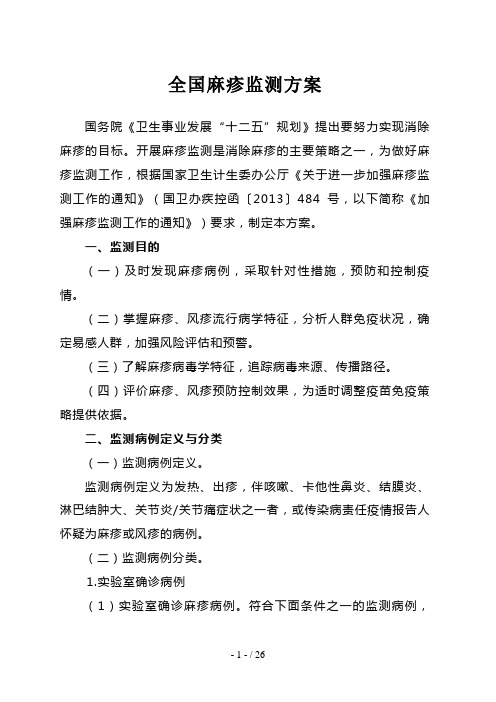
全国麻疹监测方案国务院《卫生事业发展“十二五”规划》提出要努力实现消除麻疹的目标。
开展麻疹监测是消除麻疹的主要策略之一,为做好麻疹监测工作,根据国家卫生计生委办公厅《关于进一步加强麻疹监测工作的通知》(国卫办疾控函〔2013〕484号,以下简称《加强麻疹监测工作的通知》)要求,制定本方案。
一、监测目的(一)及时发现麻疹病例,采取针对性措施,预防和控制疫情。
(二)掌握麻疹、风疹流行病学特征,分析人群免疫状况,确定易感人群,加强风险评估和预警。
(三)了解麻疹病毒学特征,追踪病毒来源、传播路径。
(四)评价麻疹、风疹预防控制效果,为适时调整疫苗免疫策略提供依据。
二、监测病例定义与分类(一)监测病例定义。
监测病例定义为发热、出疹,伴咳嗽、卡他性鼻炎、结膜炎、淋巴结肿大、关节炎/关节痛症状之一者,或传染病责任疫情报告人怀疑为麻疹或风疹的病例。
(二)监测病例分类。
1.实验室确诊病例(1)实验室确诊麻疹病例。
符合下面条件之一的监测病例,为实验室确诊麻疹病例。
①血标本检测麻疹IgM抗体阳性者;②病原学标本检测麻疹病毒核酸阳性或分离到麻疹病毒者;③恢复期血清麻疹IgG抗体滴度比急性期有≥4倍升高,或急性期抗体阴性而恢复期抗体阳转者。
(2)实验室确诊风疹病例。
符合下面条件之一的监测病例,为实验室确诊风疹病例。
①血标本检测风疹IgM抗体阳性者;②病原学标本检测风疹病毒核酸阳性或分离到风疹病毒者;③恢复期血清风疹IgG抗体滴度比急性期有≥4倍升高,或急性期抗体阴性而恢复期抗体阳转者。
2.临床诊断病例(1)流行病学联系病例①流行病学联系麻疹病例。
监测病例无标本或标本不合格,但与实验室确诊麻疹病例有流行病学关联。
②流行病学联系风疹病例。
监测病例无标本或标本不合格,但与实验室确诊风疹病例有流行病学关联。
(2)临床符合病例①临床符合麻疹病例。
具备发热、出疹并伴有咳嗽、卡他性鼻炎或结膜炎症状之一,或传染病责任疫情报告人怀疑为麻疹的监测病例,无标本或标本不合格,与实验室确诊麻疹病例无流行病学关联,未明确诊断为其他疾病者。
瘾疹(慢性荨麻疹)中医诊疗方案
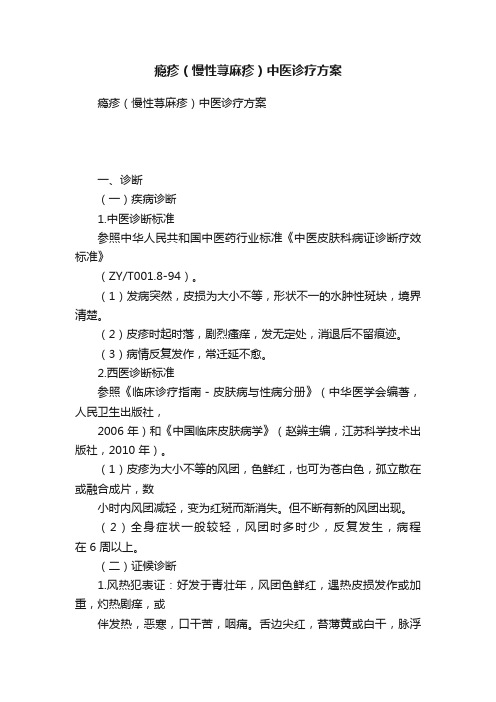
瘾疹(慢性荨麻疹)中医诊疗方案瘾疹(慢性荨麻疹)中医诊疗方案一、诊断(一)疾病诊断1.中医诊断标准参照中华人民共和国中医药行业标准《中医皮肤科病证诊断疗效标准》(ZY/T001.8-94)。
(1)发病突然,皮损为大小不等,形状不一的水肿性斑块,境界清楚。
(2)皮疹时起时落,剧烈瘙痒,发无定处,消退后不留痕迹。
(3)病情反复发作,常迁延不愈。
2.西医诊断标准参照《临床诊疗指南-皮肤病与性病分册》(中华医学会编著,人民卫生出版社,2006 年)和《中国临床皮肤病学》(赵辨主编,江苏科学技术出版社,2010 年)。
(1)皮疹为大小不等的风团,色鲜红,也可为苍白色,孤立散在或融合成片,数小时内风团减轻,变为红斑而渐消失。
但不断有新的风团出现。
(2)全身症状一般较轻,风团时多时少,反复发生,病程在 6 周以上。
(二)证候诊断1.风热犯表证:好发于青壮年,风团色鲜红,遇热皮损发作或加重,灼热剧痒,或伴发热,恶寒,口干苦,咽痛。
舌边尖红,苔薄黄或白干,脉浮数。
2.风寒束表证:风团色白或淡红,遇风寒发作或加重,得暖则减,口不渴。
舌质淡,苔白,脉浮紧。
3.胃肠湿热证:风团色红,发作时伴有腹痛,纳呆,大便秘结或便溏,甚至恶心呕吐。
舌质红,苔黄腻,脉濡数或滑数。
4.血虚风盛证:风疹块风团反复发作,色淡,瘙痒,延续数月或数年,劳累后发作或加剧。
舌质淡,苔薄,脉濡细。
二、治疗方法(一)辨证选择口服中药汤剂、中成药1.风热犯表证治法:疏风清热。
推荐方药:消风散合荆防方加减。
荆芥、防风、蝉蜕、浮萍、金银花、知母、当归、— 239 —皮肤科中医诊疗方案生地、甘草等。
中成药:消风止痒颗粒等。
2.风寒束表证治法:祛风散寒。
推荐方药:麻黄汤合玉屏风散加减。
麻黄、桂枝、荆芥、黄芪、白术、防风、甘草、蝉蜕、大枣、乌梅等。
中成药:玉屏风颗粒、桂枝颗粒等。
3.胃肠湿热证治法:清利湿热。
推荐方药:平胃散合防风通圣散加减。
防风、栀子、荆芥、陈皮、苍术、白术、厚朴、赤芍、生石膏(先煎)、黄芩等。
瘾疹(急慢性荨麻疹)
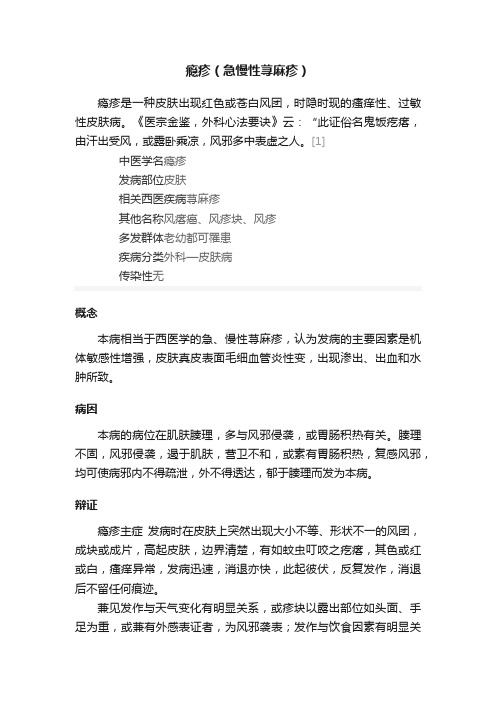
瘾疹(急慢性荨麻疹)瘾疹是一种皮肤出现红色或苍白风团,时隐时现的瘙痒性、过敏性皮肤病。
《医宗金鉴,外科心法要诀》云:“此证俗名鬼饭疙瘩,由汗出受风,或露卧乘凉,风邪多中表虚之人。
[1]中医学名瘾疹发病部位皮肤相关西医疾病荨麻疹其他名称风瘩癌、风疹块、风疹多发群体老幼都可罹患疾病分类外科—皮肤病传染性无概念本病相当于西医学的急、慢性荨麻疹,认为发病的主要因素是机体敏感性增强,皮肤真皮表面毛细血管炎性变,出现渗出、出血和水肿所致。
病因本病的病位在肌肤腠理,多与风邪侵袭,或胃肠积热有关。
腠理不固,风邪侵袭,遏于肌肤,营卫不和,或素有胃肠积热,复感风邪,均可使病邪内不得疏泄,外不得透达,郁于腠理而发为本病。
辩证瘾疹主症发病时在皮肤上突然出现大小不等、形状不一的风团,成块或成片,高起皮肤,边界清楚,有如蚊虫叮咬之疙瘩,其色或红或白,瘙痒异常,发病迅速,消退亦快,此起彼伏,反复发作,消退后不留任何痕迹。
兼见发作与天气变化有明显关系,或疹块以露出部位如头面、手足为重,或兼有外感表证者,为风邪袭表;发作与饮食因素有明显关系,伴有脘腹胀痛,大便秘结,小便黄赤,或伴有恶心呕吐,肠鸣泄泻,舌质红赤,舌苔黄腻,脉滑数者,为胃肠积热;病久不愈,热伤阴血,可导致血虚风燥之证。
治疗1.基本治疗治法疏风和营。
以手阳明、足太阴经穴为主。
主穴曲池合谷血海膈俞委中配穴风邪侵袭者,加外关、风池;肠胃积热者,加足三里、天枢;湿邪较重者,加阴陵泉、三阴交;血虚风燥者,加足三里、三阴交;呼吸困难者,加天突;恶心呕吐者,加内关。
操作主穴用毫针泻法,风寒束表或湿邪较重者可灸,血虚风燥者只针不灸。
配穴按虚补实泻法操作。
方义曲池、合谷同属阳明,擅于开泄,既可疏风解表,又能清泻阳明,故凡瘾疹不论是外邪侵袭还是肠胃蕴热者用之皆宜。
本病邪在营血,膈俞为血之会,委中又名血郄,与血海同用,可调理营血,而收“治风先治血,血行风自灭”之效。
2.其他治疗(1)耳针法选取神门、肾上腺、内分泌、肺、耳尖、耳背静脉。
慢性荨麻疹的诊断、鉴别诊断与治疗
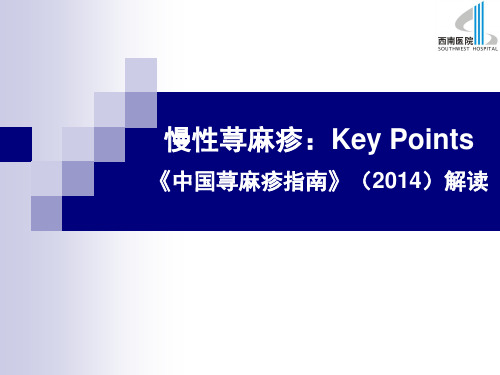
慢性荨麻疹
特发性 自身免疫 物理性 冷球蛋白 荨麻疹血管炎
感染
有明确原因的荨麻疹更像是急性荨麻疹或荨麻疹综合征
Allergy Asthma Proc 29:439 –446, 2008;
22014版中国指南对荨麻疹病因的描述
2014版中国荨麻疹指南
• 将病因分为外源性和内源性 • 外源性:物理刺激、食物、药物、植入物及运动, 强调一过性和可见性(trigger) • 内源性:自身免疫、精神因素、特异性体质等, 强调持续性和隐匿性(cause)
Zuberbier, T., et al.,. Allergy. 2014 Jul;69(7):868-87. (ref 3)
慢性荨麻疹的皮损表现形式
• 风团 • 风团+血管性水肿 • 血管性水肿
血管性水肿的特征
病变累及真皮深层和皮下组 织,也常可波及粘膜下层
突然发生,呈红色或肤色的 肿胀
表现为疼痛而非瘙痒 消失较风团慢,可持续72hr
Zuberbier, T., et al.,. Allergy. 2014 Jul;69(7):868-87. (ref 3)
慢性自发性荨麻疹伴血管性水肿比例 (国外研究报道)
Maurer M,et al.Allergy 2011; 66: 317–330.
慢性荨麻疹合并血管性水肿
(中国,不同类型,n=535)
几乎所有类型荨麻疹都可以合并血管性水肿
Zhong H, Song Z, Hao F et al. Allergy 2014; 69: 359–364.
慢性荨麻疹合并血管性水肿
(中国,不同性别,n=535)
荨麻疹诊疗指南
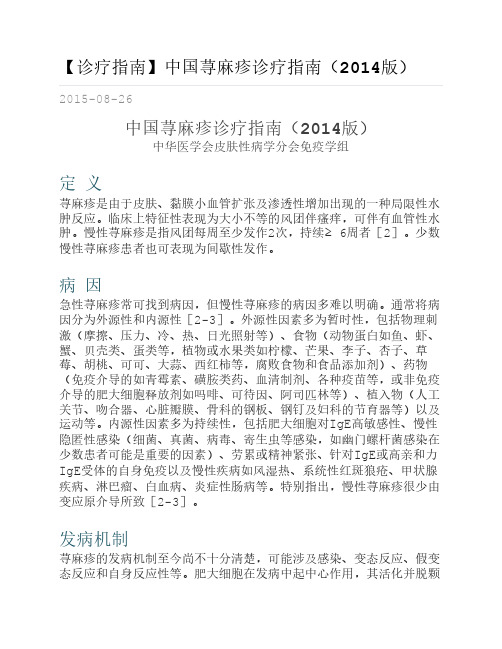
【诊疗指南】中国荨麻疹诊疗指南(2014版)2015-08-26中国荨麻疹诊疗指南(2014版)中华医学会皮肤性病学分会免疫学组定 义荨麻疹是由于皮肤、黏膜小血管扩张及渗透性增加出现的一种局限性水肿反应。
临床上特征性表现为大小不等的风团伴瘙痒,可伴有血管性水肿。
慢性荨麻疹是指风团每周至少发作2次,持续≥ 6周者[2]。
少数慢性荨麻疹患者也可表现为间歇性发作。
病 因急性荨麻疹常可找到病因,但慢性荨麻疹的病因多难以明确。
通常将病因分为外源性和内源性[2-3]。
外源性因素多为暂时性,包括物理刺激(摩擦、压力、冷、热、日光照射等)、食物(动物蛋白如鱼、虾、蟹、贝壳类、蛋类等,植物或水果类如柠檬、芒果、李子、杏子、草莓、胡桃、可可、大蒜、西红柿等,腐败食物和食品添加剂)、药物(免疫介导的如青霉素、磺胺类药、血清制剂、各种疫苗等,或非免疫介导的肥大细胞释放剂如吗啡、可待因、阿司匹林等)、植入物(人工关节、吻合器、心脏瓣膜、骨科的钢板、钢钉及妇科的节育器等)以及运动等。
内源性因素多为持续性,包括肥大细胞对IgE高敏感性、慢性隐匿性感染(细菌、真菌、病毒、寄生虫等感染,如幽门螺杆菌感染在少数患者可能是重要的因素)、劳累或精神紧张、针对IgE或高亲和力IgE受体的自身免疫以及慢性疾病如风湿热、系统性红斑狼疮、甲状腺疾病、淋巴瘤、白血病、炎症性肠病等。
特别指出,慢性荨麻疹很少由变应原介导所致[2-3]。
发病机制荨麻疹的发病机制至今尚不十分清楚,可能涉及感染、变态反应、假变态反应和自身反应性等。
肥大细胞在发病中起中心作用,其活化并脱颗粒,导致组胺、白三烯、前列腺素等释放,是影响荨麻疹发生、发展、预后和治疗反应的关键[3]。
诱导肥大细胞活化并脱颗粒的机制包括免疫性、非免疫性和特发性。
免疫性机制包括针对IgE或高亲和力IgE 受体的自身免疫、IgE依赖的以及抗原抗体复合物和补体系统介导等途径;非免疫性机制包括肥大细胞释放剂直接诱导,食物中小分子化合物诱导的假变应原反应,或非甾体抗炎药改变花生烯酸代谢等;还有少数荨麻疹患者目前尚无法阐明其发病机制,甚至可能不依赖于肥大细胞活化[2-4]。
荨麻疹隐疹(刺血疗法)
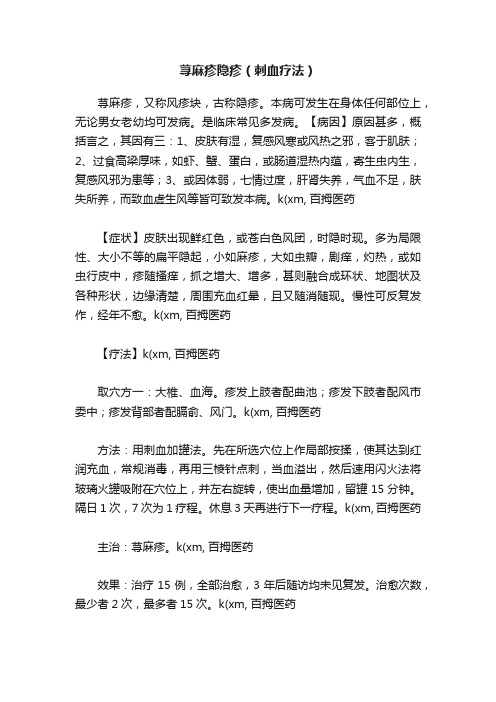
荨麻疹隐疹(刺血疗法)荨麻疹,又称风疹块,古称隐疹。
本病可发生在身体任何部位上,无论男女老幼均可发病。
是临床常见多发病。
【病因】原因甚多,概括言之,其因有三:1、皮肤有湿,复感风寒或风热之邪,客于肌肤;2、过食高梁厚味,如虾、蟹、蛋白,或肠道湿热内蕴,寄生虫内生,复感风邪为患等;3、或因体弱,七情过度,肝肾失养,气血不足,肤失所养,而致血虚生风等皆可致发本病。
k(xm, 百拇医药【症状】皮肤出现鲜红色,或苍白色风团,时隐时现。
多为局限性、大小不等的扁平隐起,小如麻疹,大如虫瓣,剧痒,灼热,或如虫行皮中,疹随搔痒,抓之增大、增多,甚则融合成环状、地图状及各种形状,边缘清楚,周围充血红晕,且又随消随现。
慢性可反复发作,经年不愈。
k(xm, 百拇医药【疗法】k(xm, 百拇医药取穴方一:大椎、血海。
疹发上肢者配曲池;疹发下肢者配风市委中;疹发背部者配膈俞、风门。
k(xm, 百拇医药方法:用刺血加罐法。
先在所选穴位上作局部按揉,使其达到红润充血,常规消毒,再用三棱针点刺,当血溢出,然后速用闪火法将玻璃火罐吸附在穴位上,并左右旋转,使出血量增加,留罐15分钟。
隔日1次,7次为1疗程。
休息3天再进行下一疗程。
k(xm, 百拇医药主治:荨麻疹。
k(xm, 百拇医药效果:治疗15例,全部治愈,3年后随访均未见复发。
治愈次数,最少者2次,最多者15次。
k(xm, 百拇医药附记:引自《上海针灸杂志》(3)1987年。
k(xm, 百拇医药取穴方二:分2组。
一为后溪;二为曲池、足三里。
k(xm, 百拇医药方法:1组穴用点刺放血法,用三棱针点刺出血数滴;2组穴用毫针刺,用泻法。
隔日1次。
k(xm, 百拇医药主治:荨麻疹。
k(xm, 百拇医药效果:临床使用多年,效果良好。
k(xm, 百拇医药附记:引自《中国针灸》(2)1984年。
k(xm, 百拇医药取穴方三:四缝穴(双)。
k(xm, 百拇医药方法:用点刺放血法。
用三棱针先点刺右手四缝穴,每穴挤出如豆大小的白色粘液,1周后,复点刺左手四缝穴,以巩固疗效。
贺普仁治疗瘾疹(荨麻疹)

贺普仁治疗瘾疹(荨麻疹)中医有句名言,说“内不治喘,外不治癣”,可见喘证和皮肤病是很不好治的两种病。
但是相比较而言,针灸治疗皮肤病还是有一定优势的。
瘾疹(荨麻疹)方【病症:瘾疹(荨麻疹)】瘾疹是一种常见的过敏性皮肤病,以皮肤上出现鲜红色或苍白片状疹块,并伴有瘙痒为特征。
本病多因禀赋不受,又食鱼虾等腥荤动风之物;或因饮食失节胃肠实热;或因平素体虚卫表不固,复感风热、风寒之邪,郁于皮毛肌腠之间而发病;再有情志不遂,肝郁不舒,气机不畅,郁而化火,灼伤阴血,感受风邪而诱发。
【针方组成】曲池、合谷、血海、三阴交。
【针方临证】风热型:发病急骤,风团色红灼热剧痒,伴有发热恶寒、咽喉肿痛或呕吐、腹痛,遇热皮疹加重。
舌苔薄白或薄黄,脉浮数。
风寒型:皮疹色呈粉白,遇风冷皮疹加重,口不渴,或有腹泻。
舌体淡胖,苔白,脉浮紧。
阴血不足型:皮疹反复发作,迁延日久,午后或夜间加剧,心烦易怒口干,手足心热。
舌红少津或舌质淡,脉沉细。
【随证加减】风热型加风池,风寒型加风市,阴血不足型加足三里。
【临床操作】曲池、血海、三阴交毫针直刺泻法1~1.5寸,合谷直刺0.5~1寸,风市直刺1~2寸,内庭泻法直刺0.5寸,风池斜刺0.5寸,足三里直刺1.5寸用补法。
【针方明理】曲池、合谷分别为手阳明大肠经之合穴、原穴,善于开泄散风清热;脾经之穴血海可清血中郁热,三阴交养血凉血;风市散风驱寒,风池祛风清热;足三里健运脾胃调气养血。
贺普仁教授在临床上运用此方治疗荨麻疹效果良好,同时强调辨明病因,辨证施治。
对急性期患者,要祛风止痒;对慢性患者,要扶正健脾养血为治疗法则。
【按语】西医认为本证特点是初起皮肤局部发生瘙痒,抓后皮肤潮红,迅即发生形状不一、大小不等的鲜红色或瓷白色风团,剧烈瘙痒,此起彼伏,越抓越多,数小时后逐渐消退,一日之内可发作数次。
一般皮疹泛发全身,黏膜亦可受累。
发生于胃肠部可伴有腹痛腹泻;发生在喉头黏膜,则可引起喉头水肿产生呼吸困难、胸闷憋气,严重者可窒息。
- 1、下载文档前请自行甄别文档内容的完整性,平台不提供额外的编辑、内容补充、找答案等附加服务。
- 2、"仅部分预览"的文档,不可在线预览部分如存在完整性等问题,可反馈申请退款(可完整预览的文档不适用该条件!)。
- 3、如文档侵犯您的权益,请联系客服反馈,我们会尽快为您处理(人工客服工作时间:9:00-18:30)。
2014年瘾疹(荨麻疹)诊疗方案
一、概述
荨麻疹俗称风团,是一种常见的皮肤病,是由各种因素致使皮肤黏膜血管发生暂时性炎性充血与大量液体渗出,造成局部水肿性的损害。
其迅速发生与消退,有剧痒。
可有发热、腹痛、腹泻或其他全身症状。
可分为急性荨麻疹、慢性荨麻疹与丘疹状荨麻疹等。
二、诊断
(一)疾病诊断
1.中医诊断标准
(1)突然发作,皮损为大小不等,形状不一的水肿性斑块,境界清楚。
(2)皮疹时起时落,剧烈瘙痒,发无定处,退后不留痕迹。
(3)部分病例可有腹痛腹泻,或有发热、关节痛等症。
严重者可有呼吸困难,甚至引起窒息。
(4)皮肤划痕试验阳性。
(5)皮疹经过三个月以上不愈或反复间断发作者为慢性瘾疹。
2.西医诊断标准
(1)皮肤出现大小不等之风团样损害,骤然发生,迅速消退,瘙痒剧烈,愈后不留痕迹。
(2)慢性荨麻疹,风团损害反复发作,时间持续1~3个月以上。
(3)实验室检查,皮肤过敏源检查可查到阳性结果;血清IgE 水平增高。
(二)证候诊断
1.风热犯表证:风团鲜红,灼热剧痒。
伴有发烧、恶寒、咽喉肿痛,遇热则皮疹加重。
舌苔薄白或薄黄,脉浮数。
2.风寒束表证:皮疹色白,遇风寒加重,得暖则减,口不渴。
舌质淡,舌苔白,脉浮紧。
3.胃肠湿热证:风团片大,色红,瘙痒剧烈,发疹的同时伴脘腹疼痛,恶心呕吐,神疲纳呆,大便秘结或泄泻。
舌质红,苔黄腻,脉弦滑数。
4.血虚风燥证:反复发作,迁延日久,午后或夜间加剧。
伴心烦易怒,口干,手足心热。
舌红少津,脉沉细。
(三)鉴别诊断
1.中医鉴别诊断
(1)与水疥鉴别:水疥好发于儿童,多见于春夏秋季,好发部位为四肢、腰腹部、臀部,典型皮损为纺锤形丘疹,色红,长轴与皮纹平行,中央常有针尖大小的红斑或水疱,瘙痒剧烈。
(2)与猫眼疮鉴别:猫眼疮可发生于任何年龄,春秋季多见,好发于手足背、掌底、四肢伸侧等处,皮损呈多形性,有红斑、丘疹、风团、水疱、大疱等,常两种以上皮损同时存在,典型皮损为猫眼,即虹彩状,色暗红或紫红。
2.西医鉴别诊断
(1)与血管性水肿鉴别:血管性水肿为慢性复发性真皮深层及皮下组织的大片局部性水肿,病因及发病机制与荨麻疹相同,只是血浆是从真皮深部或皮下组织的小血管内皮细胞间隙中渗出,而进入到周围疏松组织内而引起。
(2)与胃肠炎及某些急腹症鉴别:荨麻疹样血管炎风团持续时间长达24~72小时,伴有发热,关节痛,血沉增快,低补体血症,病理检查为破碎性血管炎改变,伴有呕吐,腹泻,腹痛等症状时,应与胃肠炎及某些急腹症鉴别。
三、治疗方案
(一)辨证选择口服中药汤剂或中成药
1.风热犯表证:
治法:清热疏风。
方药:消风散加减。
组成:生石膏(先煎)30g 荆芥10g 防风10g 生地30g 牛蒡子10g 赤芍10g 浮萍10g 苦参10g
苍术10g 蝉蜕6g 木通10g 生甘草6g
水煎至400ml,分早晚饭后二次服。
中成药:银翘解毒丸,每次1-2丸,每日2次;皮肤病血毒丸,每次20粒,每日2次。
2.风寒束表证
治法:祛风散寒,调和营卫。
方药:麻黄桂枝各半汤加减。
组成:炙麻黄3g 桂枝10g 白芍10g 荆芥10g
防风10g 蝉衣6g 生姜6g 大枣3枚
炙甘草6g
水煎至400ml,分早晚饭后二次服。
中成药:感冒冲剂,每次2袋,每日2次。
3.胃肠湿热证:
治法:疏风解表,通腑泄热。
方药:防风通圣散加减。
组成:炙麻黄3g 防风10g 荆芥10g 厚朴10g
枳壳10g 黄芩10g 茵陈15g 赤芍10g
生大黄(后下)6g 薄荷(后下)6g
六一散(包煎)10g
水煎至400ml,分早晚饭后二次服。
中成药:防风通圣丸,每次6克,每日2次。
4.血虚风燥证:
治法:补气养血,祛风止痒。
方药:八珍汤加减。
组成:党参10g 白术10g 茯苓15g 当归10g
赤芍10g 蝉衣6g 白芍10g 川芎10g
生地15g 荆芥10g 防风10g 蒺藜15g
炙甘草6g
水煎至400ml,分早晚饭后二次服。
中成药:玉屏风散,每次1袋,每日2次;归脾丸,每次1丸,每日2次。
(二)外治法
1.风团色红时,炉甘石洗剂外涂;风团色白者,用百部酊外涂,每日3次。
2.香樟木或晚蚕砂30-60g,煎汤熏洗。
适用于慢性瘾疹。
3.本科协定方荨麻疹方(防风20g、艾叶20g、苦参30g、荆芥20g、白鲜皮30g、蛇床子30g、乌蛇20g)水煎后行全身中药薰洗治疗。
(三)针灸疗法
1.体针:取风府、曲池、血海、合谷、足三里、大椎、膈腧等穴。
2.拔罐疗法:在神阙穴拔火罐,每日1次,每次10-15分钟。
(四)其他疗法
1.穴位注射疗法:选用双侧曲池、三阴交、足三里穴、用复方丹参注射液做穴位注射,每穴注射1毫升,每周一次,4次为1疗程。
2.自血疗法:从静脉内抽血,立即注射于臀部肌肉内,每周2-3
次,第一次5ml,以后每次10ml,10次为一疗程。
(五)西医治疗
1.抗组胺药:5%葡萄糖注射液250ml+西咪替丁注射液0.6g+维生素B6注射液0.3g,静滴,1次/日;地氯雷他定:5mg 口服每日1次;盐酸左西替利嗪:5mg 口服每日1次。
2.降低血管壁通透性的药物,如维生素C、钙剂:5%葡萄糖注射液100ml+维生素C注射液2g+10%葡萄糖酸钙注射液20ml;静滴,1
次/日。
3.糖皮质激素:荨麻疹如皮疹广泛、发病急,可应用泼尼松、甲泼尼龙或地塞米松等。
4.静脉滴注中成药注射液,如苦参注射液、复方甘草酸苷注射液;
5.炉甘石洗剂等外用止痒剂,外搽每日3次。
6.免疫抑制剂:甲氨蝶呤、环孢素、硫唑嘌呤等可单用或与第
二代抗组胺药物联合应用。
7.免疫球蛋白:丙种球蛋白等,用药时间视病情而定。
8.拟交感神经药:0.1%的肾上腺素用于严重的急性荨麻疹。
9.伴发症状的治疗:伴喉头水肿、呼吸困难时,除使用肾上腺
素和糖皮质激素外,必要时可行气管切开。
(六)护理
1.饮食:一般给予普食,少食油腻食物,忌食酒类、辛辣刺激性发物动风之品。
2.情绪调理:勤与患者沟通,可采用倾听、安慰病人的方法,避免急躁不安情绪,忌恼怒,心情舒畅,保持良好情绪。
3.健康指导:向患者讲解本病特点、治疗过程、用药常识、预防复发措施及注意事项。
指导患者生活规律,起居有常,合理调配饮食,调整胃肠道功能,治疗慢性病灶,避免接触已发现能致敏的食物、药物、动物皮毛等,以防本病复发。
四、疗效判定
参照中华人民共和国中医药行业标准《中医病证诊断疗效标准》
(ZY/T001.8-94)
1.治愈:风团消退,临床体征消失,不再发作者。
2.好转:风团消退30%或消退后复发间隔时间延长,瘙痒等症状减轻者。
3.未愈:风团及瘙痒无明显改善者,或消退不足30%。
